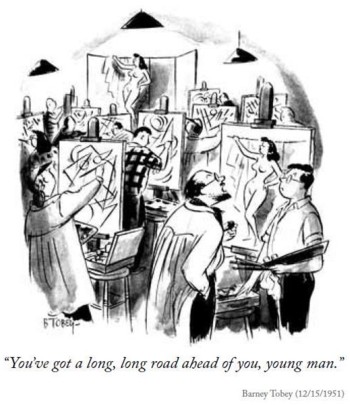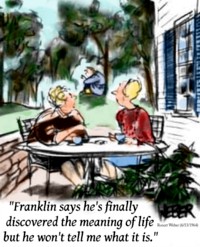Art
The artist does not draw what he sees, but what he has to to make others see.[58]
'Art' has a wide range of meanings ranging from skill to the expression of culture. Again this is a subject that fills libraries and I do not intend to say more than a few words. I want to talk for a brief moment about pictures. But much of what I say has parallels in the other arts.
When children are little they quickly learn to draw pictures. In our culture they first draw a face then they may attach limbs; arms where the ears should be legs out of the neck. Similarly they draw a house or a tree as a symbol; not as a realistic (photographic) drawing. So from the earliest time we use pictures as a means of communication or expression; not a representation of how the world really looks.
It is only very recently that artists attempted to use art to show how the world actually looks. The perspective that we see in a photograph, on TV, in a modern landscape or any other 'realistic' two-dimensional representation of the three-dimensional world has been understood for less than 600 years.
For all of human history preceding this understanding, pictures were a kind of conversation between the artist and the viewer. Many artists want this to remain the case.
Great art requires both a shared understanding with the viewer and something important to say. Traditionally art has been allowed to express things about passion, both the human sexual condition and closely related religious passion.
These were not allowed to be expressed, or would be difficult to express, in words. A quick look through a museum catalogue will confirm that greatest part of our most highly regarded art is about basic human passions. These are mainly sexual or religious (as repressed sex for example: ecstasy, martyrs and myths), quite a bit is about ways of seeing nature and the remainder is mainly about asserting social status or sometimes politics and a range of other cultural issues. Very little is about composition or beautiful brushwork.
In recent times other media has taken over some of the things that paintings and drawings once did exclusively. This started with black and white photography but now extends to moving images in colour and interactive computer based images. This has removed the scope for much literal depiction of nature or documentary art and has encouraged impressionism and non-figurative forms.

Art continues to have conventional symbolism; a 'language' based on the work of those who went before. This leads to schools of art and fashions in the language of art: Religious iconography, Classicism, Expressionism, Cubism, Modernism, post-modernism and so on.
The problem for artists is that many of their viewers do not speak the same language (some forms may take years of art education to comprehend) and so their message is either misunderstood and taken to mean something entirely different or disregarded altogether.
The problem for viewers is that many artists either have nothing interesting to say or that what they are trying to say is onanistic; poorly executed; or drivel; dressed up by the mystique of 'Art'. We might expend the effort to understand the artist's language only to find some trivial, untrue or distasteful message (what is Juan Davila on about).
Worse there are some who simply repeat a meaningless commercial image with the single intention of making a sale. This may be 'craft' but it is not art.
We all need to give art (and music) some attention and effort. A rounded person needs to have a basic understanding of the main languages of art and to be able to use art as a means of communication, either by making it or by using it in their lives.

